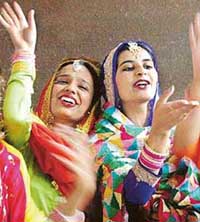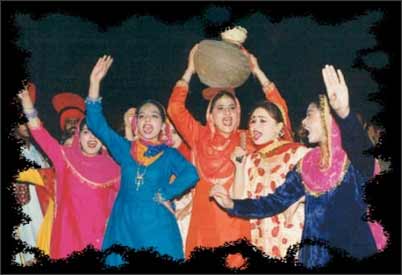Shaukeen Jatti
Giddheyan di rani
Bhangra
Giddha
Jhumar
Luddi
Dankara
Julli
Sammi
Dhamal
Jaago
Kikli
Gatka
Giddha
Jhumar
Luddi
Dankara
Julli
Sammi
Dhamal
Jaago
Kikli
Gatka
[SIZE=+2]Bhangra[/SIZE]
Originally, Punjabis performed Bhangra to celebrate the sucess of the harvest. Now people perform Bhangra at wedding parties, receptions, birthdays, competitions, and other happy occations. On the day of Baisakhi, April 13, many farmers, engineers, teachers, shop owners, and other sorts of people perform Bhangra. In the villages, with large drums, called dhols, people circle round and round leaping and laughing. Persons of all types of social classes perform Bhangra together. Even the elders occationally join the young to celebrate and dance Bhangra. [SIZE=+2]Giddha[/SIZE]
Giddha is Punjab's most famous folkal dance for women. In Giddha, the women enact verses called bolis, folk poetry, and dance. The subject matter of these bolis include everything from arguments with the father-in-law to political affairs. The dance rhythm is set by the dhols and the distinctive hand claps of the dancers. These days, people associate Giddha with Bhangra.
[SIZE=+2]Jhumar[/SIZE]
This dance, originally from Sandalbar (now in Pakistan), is very much a part of Punjab's folk heritage. It is a graceful dance based on a Jhumar rhythm. Dancers circle around the drummer and sing graceful lyrics as they dance.
[SIZE=+2]Luddi[/SIZE]
Luddi is a victory dance where people do special movements of their heads. The costume is a simple loose shirt. The dancers put one hand on their backs and the other hand in front of their faces. The body movement is sinuous, snake-like. There is also a drummer in the center of the dance.
[SIZE=+2]Dankara[/SIZE]
Also called the Gaatka dance, this is a dance of celebration. Two men, each holding colorful staves, in rhythm with the drums dance round each other and tap their sticks together. This dance is often part of marriage celebrations.
[SIZE=+2]Julli[/SIZE]
Muslim holymen, called pirs, perform this dance. Generally they dance in their hermitages (khangahs). People perform the dance while sitting. Sometimes they dance around the preceptor's grave. Normally the dancer wears black.
[SIZE=+2]Sammi[/SIZE]
Traditionally women of the Sandalbar region, now in Pakistan, perform Sammi. The dancers dress in bright coloured kurtas and full flowing skirts called lengas. A particular silver hair ornament is associated with this dance.
[SIZE=+2]Dhamal[/SIZE]
Similar to bhangra, men dance in a circle.
[SIZE=+2]Jaago[/SIZE]
Literally Jaago means wake up! When there is a marriage in the house, girls dance through the village streets carrying a pot (gaggar) decorated with lightened candles and sing Jaagu songs. The themes of the songs are social and usually a bit of teasing, often aimed at elders, goes with the song.
[SIZE=+2]Kikli[/SIZE]
Women perform this dance in pairs. They cross their arms, hold each other`s hands and whirl around singing folk songs. Sometimes four girls join hands to perform this dance.
[SIZE=+2]Gatka[/SIZE]
Gatka is a Sikh martial art in which people use swords, sticks, and daggers. People believe that Guru Hargobind Sahib started the art of gatka after the martyrdom of fifth guru Guru Arjan Dev. Wherever there is a large Khalsa Sikh population, there will be Gatka participants, which can consist of small children and adults. These participants usually perform Gatka on special holidays such as Bhaisakhi and Gurpurab.






